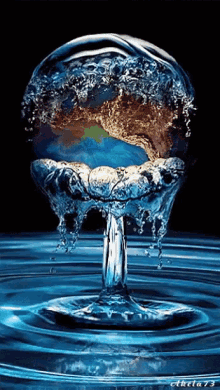Examining the Influence of Large-Scale Hydroelectric Projects on Earth's Rotation, Polarity Shifts, and Magnetic Reversals
Abstract
The construction of large-scale hydropower projects, such as the Three Gorges Dam, has raised concerns regarding their potential impact on Earth’s rotational dynamics, specifically the axial tilt (obliquity) and its implications for global climate systems. As mass redistribution from these projects could theoretically affect the Earth’s rotation, this study aimed to investigate whether the changes in mass distribution due to the Three Gorges Dam have any measurable effect on the Earth’s axial tilt. This study aimed to evaluate the possible relationship between large-scale hydrological projects and changes in the Earth's rotational characteristics, focusing on obliquity. This was accomplished by combining historical climate records, mathematical models, and satellite-based observational data. Axial tilt measurements from NASA's Earth Orientation Parameters dataset were used to predict and analyze the changes in the moment of inertia caused by the dam's water impoundment. Simulations showed that the Earth's rotational dynamics would only be slightly affected, well below the threshold needed to produce any discernible climatic changes. The study concludes that large-scale hydropower projects, including the Three Gorges Dam, do not have a significant impact on Earth’s axial tilt or long-term climate systems. These findings contribute to the broader understanding of how human-induced changes in mass distribution influence Earth’s rotational dynamics and underscore the resilience of the planet’s natural systems to such interventions.
Keywords
Full Text:
PDFReferences
Adhikari, S., & Ivins, E. R. (2016). Climate-driven polar motion: 2003–2015. Science Advances, 2(4), e1501693.
Bizouard, C., & Rothacher, M. (2011). The International Earth Rotation and Reference Systems Service (IERS): Activities and Developments. Journal of Geodesy, 85(11), 659-666. https://doi.org/10.1007/s00190-011-0486-9
Chao, B. F. (2005). On the geophysical effects of the Three Gorges Dam. Journal of Geodynamics, 40(4-5), 456-463. https://doi.org/10.1016/j.jog.2005.07.002
Chao, B. F., & O'Connell, R. J. (1993). Effects of large-scale hydrological phenomena on the Earth's rotation. Science, 260(5113), 1997-2000. https://doi.org/10.1126/science.260.5113.1997
Chao, B. F., O’Connor, W. P., Chang, A. T., Hall, W. E., & Foster, J. L. (1995). Snow load effect on Earth’s rotation and gravitational field. Nature, 373(6513), 527–530.
Chen, J. L., Wilson, C. R., & Tapley, B. D. (2004). The impact of large-scale water impoundments on Earth's rotation. Geophysical Research Letters, 31(16), L16603. https://doi.org/10.1029/2004GL020188
Chen, J. L., Wilson, C. R., & Tapley, B. D. (2013). Contribution of ice sheet and mountain glacier melt to recent polar motion. Geophysical Research Letters, 40(5), 1124–1128.
Cohen, J. (1988). Statistical power analysis for the behavioral sciences (2nd ed.). Lawrence Erlbaum Associates
Friis-Christensen, E., et al. (2006). The Swarm mission: A new global geospace mission. Geophysical Research Letters, 33(8), L08103. https://doi.org/10.1029/2005GL025370
Glatzmaier, G. A., & Roberts, P. H. (1995). A three-dimensional self-consistent computer simulation of a geomagnetic field reversal. Nature, 377(6546), 203-209. https://doi.org/10.1038/377203a0
Goshu, B.S., (2024), Magnetic Pole Reversal: Bridging Scientific Understanding and Spiritual Significance in World Religions, Journal of Social, Cultural and Political Studies, SIASAT, 9 (4), 231-248, DOI: https://doi.org/10.33258/siasat.v9i4.187
Goshu, B.S., (2025), Unraveling the Drift: Understanding the Accelerated Movement of Earth's Magnetic North Pole toward Siberia, Britain International of Exact Sciences (BIoEx) Journal, 7(2), 79-99, DOI: https://doi.org/10.33258/bioex.v7i2.1285
Gross, R. S., & Chao, B. F. (2006). The rotational and gravitational signature of the Three Gorges Dam. Eos, Transactions American Geophysical Union, 87(52), 585-586. https://doi.org/10.1029/2006EO520003
Gross, R. S., & Peltier, W. R. (2004). The effect of large reservoirs on the Earth's rotation and on polar motion. Geophysical Research Letters, 31(11), L11603. https://doi.org/10.1029/2004GL020288
Gubbins, D. (1999). The distinction between geomagnetic excursions and reversals. Geophysical Journal International, 137(2), 325–334. https://doi.org/10.1046/j.1365-246X.1999.00808.x
Gubbins, D., & Herrero-Bervera, E. (2007). Encyclopedia of geomagnetism and paleomagnetism. Springer. https://doi.org/10.1007/978-1-4020-4423-6
Hong, S. H., Kim, S. J., & Kim, J. S. (2007). Local geomagnetic field variations and the effects of large-scale hydropower projects. Geophysical Research Letters, 34(9), L09302. https://doi.org/10.1029/2007GL029565
Ivins, E. R., et al. (2021). Hydrological loading and its impact on polar motion. Journal of Geophysical Research: Solid Earth, 126(2), e2020JB020380
Kono, M., & Roberts, P. H. (2002). Dynamics of the geodynamo. In Earth’s Core: Dynamics, Structure, and Evolution (pp. 135-150). Cambridge University Press. https://doi.org/10.1017/CBO9780511535789.008
Lambeck, K. (1983). The Earth's rotation and its geophysical implications. Geophysical Journal International, 74(3), 499-530. https://doi.org/10.1111/j.1365-246X.1983.tb04989.x
Lambeck, K. (2005). Geophysical Geodesy: The Slow Deformations of the Earth. Oxford University Press.
Lourens, L. J., Sluijs, A., Kroon, D., Zachos, J. C., Thomas, E., Röhl, U., ... & Pälike, H. (2005). Astronomical pacing of late Paleocene to early Eocene global warming events. Nature, 435(7045), 1083–1087. https://doi.org/10.1038/nature03814
Melchior, P. (1983). Earth's rotation and large-scale reservoirs. Journal of Geophysical Research, 88(B12), 9797-9802. https://doi.org/10.1029/JB088iB12p09797
Merrill, R. T., McElhinny, M. W., & McFadden, P. L. (1998). The Earth's magnetic field: Its history, origin, and planetary perspective. Academic Press.
Merrill, R. T., McFadden, P. L., & McElhinny, M. W. (1996). The magnetic field of the Earth: Paleomagnetism, the core, and the deep mantle. Academic Press.
Munk, W. H., & MacDonald, G. J. F. (1960). The Rotation of the Earth: A Geophysical Discussion. Cambridge University Press.
Peltier, W. R. (1998). Postglacial variations in the Earth's rotation: Evidence for a substantial increase in the length of the day since the Last Glacial Maximum. Geophysical Research Letters, 25(10), 1677–1680. https://doi.org/10.1029/98GL01111
Roberts, P. H., & Glatzmaier, G. A. (2000). Geodynamo theory and simulations. Reviews of Geophysics, 38(3), 259-276. https://doi.org/10.1029/2000RG000085
Seidelmann, P. K., et al. (2004). Explanatory Supplement to the Astronomical Almanac. University Science Books.
Tauxe, L. (2010). Paleomagnetic principles and applications. Cambridge University Press.
Valet, J. P., Laj, C., & Clement, J. (1996). Geomagnetic polarity reversals and their timing. Reviews of Geophysics, 34(4), 627-648. https://doi.org/10.1029/96RG02224
Wu, P., Wang, H., & Steffen, H. (2012). The role of glacial isostatic adjustment in Earth's rotation changes. Journal of Geodesy, 86(10), 879-890. https://doi.org/10.1007/s00190-012-0557-2
Zhong, S., & Zhang, N. (2011). Effects of the Three Gorges Dam on Earth’s Rotation. Nature Geoscience, 4(3), 145–149. https://doi.org/10.1038/ngeo1079
DOI: https://doi.org/10.33258/birex.v7i2.8086
Article Metrics
Abstract view : 0 timesPDF - 0 times
Refbacks
- There are currently no refbacks.

This work is licensed under a Creative Commons Attribution-ShareAlike 4.0 International License.

This work is licensed under a Creative Commons Attribution-ShareAlike 4.0 International License.

_.gif)
















_.gif)


